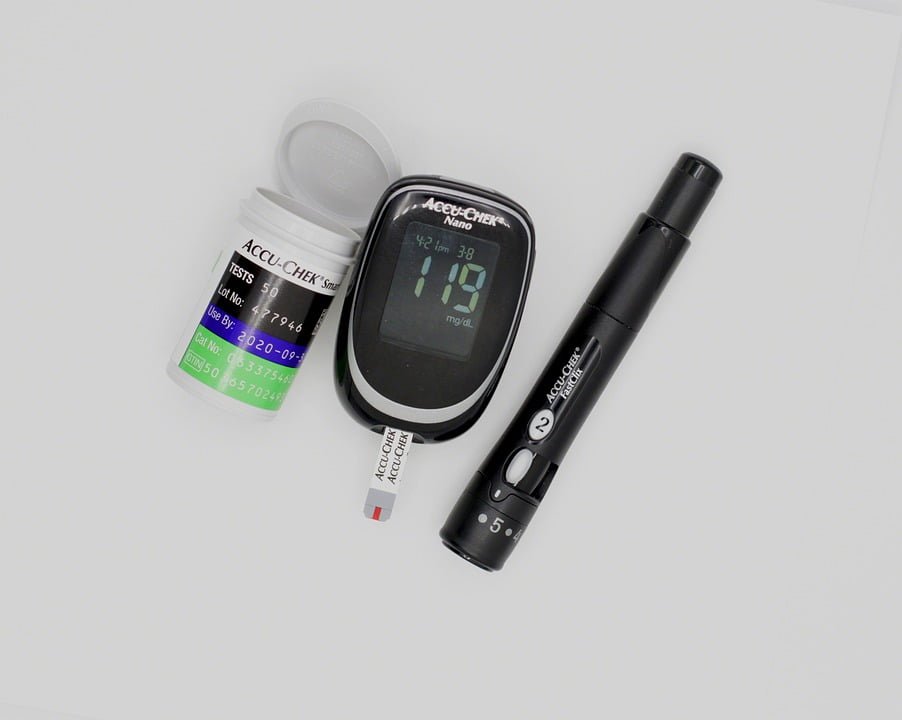A Glucometer is a medical device that is used to check blood glucose at home and OPD clinics. It is a small hand-held device used for the measurement of blood glucose levels.
A glucometer is also called a glucose meter. This device is programmed to test your blood sugar level by using a single drop of blood.
Some glucometers also have built-in features that keep a record of your results. They are portable which means they can be taken and used anywhere at any time.
Why is a Glucometer so important?
A Glucometer is an essential piece of equipment for people with diabetes as it helps with understanding their blood glucose levels.
Doctors usually tell their diabetic patients to monitor their glucose levels at home. This is also called SMBG or Self-monitoring of blood glucose.
So, people who are on intensive insulin therapy (multiple injections of insulin every day) need to keep monitoring their glucose levels.
Experienced diabetic individuals can then adjust their diabetes medications and insulin dose according to their blood glucose levels.
Glucometers are easy to use. Therefore, even kids and older people can operate this device with ease.
In this way, they can manage their sugar levels and reduce the risks of diabetes-related complications, especially hypoglycemia and hyperglycemia.
| You may also like to read: |
Another important benefit of glucometers is that they help with tracking the effects of food, exercise, infections, or other diseases on their glucose levels.
Some novel glucometers have built-in technology that also checks a person’s blood ketones.
Monitoring ketones is especially important for patients with diabetes type 1 and elderly patients who are insulin deficient and are at risk of developing diabetic ketoacidosis.
Diabetic ketoacidosis is also a major side effect of novel drugs called SGLT2 Inhibitors. These include Empagliflozin, Dapagliflozin, Canagliflozin, and Ertugliflozin.
How to Use a Glucometer?

Properly read the manual that comes with your device or follow the instructions provided by your physician before you use your glucometer.
- Keep your glucometer and test strips prepared
- Wash your hands or sanitize them properly
- Warm your hands, to increase blood flow, by rubbing your hands together for a few seconds
- After you have turned on the monitor, place the test strip inside it and wait for it to be ready for the sample
- Pierce your finger and place the blood drop on the side of your test strip
- It will take a little while for the glucometer to display your readings
- Note down your readings in a notebook so that your healthcare physician can make a proper treatment plan for you.
| You may also like to read: |
Types of Glucometers:
With advancements in the technical industry, various types of glucometers have been invented. According to your comfort level, you can select which type of glucometer suits your lifestyle the most.
Minimally Invasive Glucometers (noninvasive)
As the name suggests, this type of glucometer does not require you to prick your finger for a blood sample 6-7 times per day.
Rather, they contain a sensor that can be placed on your arm and it will provide you with a measurement of your blood sugar level almost instantly.
This is actually a better option for people who do not find pricking their fingers comfortable.
On the other hand, a disadvantage is that this type is still not capable of giving accurate results and the sensor does not stay in place all the time as well.
| You may also like to read: |
Invasive Glucometers:
This type is the most commonly used glucometer. It requires a blood sample from your fingertip. With the use of a lancet or test strips, you can prick your finger and acquire a blood sample.
These lancets or test strips can be replaced with new ones. They are small devices and unfortunately, invasive glucometers also do not give accurate results.
Continuous Glucose Monitoring (CGM):
You can tell by the name; this type of glucometer enables you to read and monitor your blood glucose level continuously and it is comparatively cheaper.
It has a disposable sensor, and a transmitter that is linked to that sensor and the measurement can be read through the reader that displays it. CGM’s sensor can be placed under your skin.
It is a type of noninvasive glucometer as it frees the user of the need to prick his/her finger for a sample. It can give you a reading for many days until the sensor has to be replaced.
But there is a downside, this device is not eligible for giving accurate measurements as it gives a reading of glucose ranges in the interstitial fluid instead of blood.
| You may also like to read: |
How accurate is a glucometer?
Technically glucometers are expected to give accurate results and, in most cases, they can give measurements that are close to accurate. Glucose readings shown by a glucometer that fall within 10 – 15% of the laboratory standards are considered acceptable.
The WHO and FDA recommend only glucometers whose values fall within the maximum of 20% of the laboratory standard.
On the other hand, the American Diabetes Association (ADA) recommends using devices with values not exceeding 5% of the laboratory standards.
Glucometer readings should fall within 15% of the laboratory standards
In one study, only 39% of the blood glucose readings fell within 15% of the laboratory standards [Ref]. Thus, about two readings out of every three blood glucose readings may be falsely high or low.
There are some factors that can possibly affect the accuracy of a glucometer. Once learned, these factors and their effect can be resolved.
Foreign Substances on Your Skin:
- Substances like dirt or alcohol from any sanitizer can stay on your skin and impure the blood sample which leads to an inaccurate test result.
Ineffective Monitor:
- Another reason for the inaccuracy of test results can be that your monitor’s battery needs to be replaced which is why it is ineffective.
Temperature:
- If you keep your test strips and monitor at a temperature that is either too hot or too cold for your glucometer then surely your readings will be affected
Blood Applied to The Strip:
- In case you have applied too little blood, your glucometer will not give proper results as it needs a good amount of blood applied to the test strip.
Increased Levels of Particular Substances in Blood:
- Substances like hematocrit or ascorbic acid can interfere with the proper reading.
Expired Test Strips:
- If your test strips have expired then understandably, they will not give a proper reading.
Need of Calibration:
- Previous glucometers have to be coded with the test strips being used, or else the accuracy of the test results will be undermined.
Site of Blood Sample:
- Taking a blood sample from any site other than your fingertips can interfere with the test results.
| You may also like to read: |
You can make certain that your test results are accurate by making sure that;
- You take a blood sample only from your fingertips
- Your fingertips are completely clean and dried before you take a sample
- Test strips are perfectly coded with your glucometer
- The glucometer and test strips are kept at a room temperature
- Test strips and batteries are replaced if needed
How much does a glucometer cost?
There is a wide range of glucometers available at different prices. You can easily buy them online or from your nearest pharmacies.
The price ranges from USD 15 to USD 50. The startup kit with replaceable sensors of a continuous glucose monitor costs around USD 1000 $
A list of commonly available glucometers is given here.
- Accu-check Active blood glucose meter
- Accu-Chek Performa blood glucose meter
- Accu-Chek Instant
- Accu-Chek Instant S
- Accu sure glucometer
- FreeStyle Blood Gluco Meter by Abbott
- Easy max Blood Glucose Meter
- Contour plus glucometer
- On Call plus glucometer
- One touch glucometer
| You may also like to read: |




